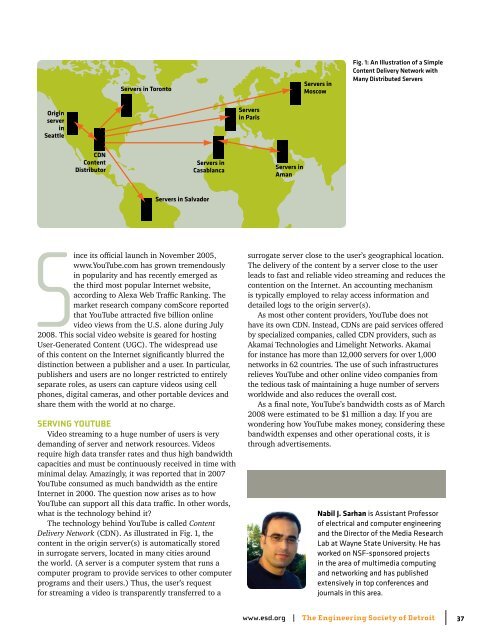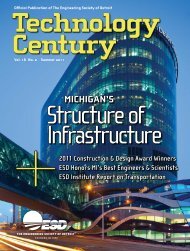YouTube Science & Engineering Camps for Kids - ESD
YouTube Science & Engineering Camps for Kids - ESD
YouTube Science & Engineering Camps for Kids - ESD
Create successful ePaper yourself
Turn your PDF publications into a flip-book with our unique Google optimized e-Paper software.
Servers in Toronto<br />
Servers in<br />
Moscow<br />
Fig. 1: An Illustration of a Simple<br />
Content Delivery Network with<br />
Many Distributed Servers<br />
Origin<br />
server<br />
in<br />
Seattle<br />
Servers<br />
in Paris<br />
CDN<br />
Content<br />
Distributor<br />
Servers in<br />
Casablanca<br />
Servers in<br />
Aman<br />
Servers in Salvador<br />
ince its official launch in November 2005,<br />
www.<strong>YouTube</strong>.com has grown tremendously<br />
in popularity and has recently emerged as<br />
the third most popular Internet website,<br />
according to Alexa Web Traffic Ranking. The<br />
market research company comScore reported<br />
that <strong>YouTube</strong> attracted five billion online<br />
video views from the U.S. alone during July<br />
2008. This social video website is geared <strong>for</strong> hosting<br />
User-Generated Content (UGC). The widespread use<br />
of this content on the Internet significantly blurred the<br />
distinction between a publisher and a user. In particular,<br />
publishers and users are no longer restricted to entirely<br />
separate roles, as users can capture videos using cell<br />
phones, digital cameras, and other portable devices and<br />
share them with the world at no charge.<br />
SERVING YOUTUBE<br />
Video streaming to a huge number of users is very<br />
demanding of server and network resources. Videos<br />
require high data transfer rates and thus high bandwidth<br />
capacities and must be continuously received in time with<br />
minimal delay. Amazingly, it was reported that in 2007<br />
<strong>YouTube</strong> consumed as much bandwidth as the entire<br />
Internet in 2000. The question now arises as to how<br />
<strong>YouTube</strong> can support all this data traffic. In other words,<br />
what is the technology behind it?<br />
The technology behind <strong>YouTube</strong> is called Content<br />
Delivery Network (CDN). As illustrated in Fig. 1, the<br />
content in the origin server(s) is automatically stored<br />
in surrogate servers, located in many cities around<br />
the world. (A server is a computer system that runs a<br />
computer program to provide services to other computer<br />
programs and their users.) Thus, the user’s request<br />
<strong>for</strong> streaming a video is transparently transferred to a<br />
surrogate server close to the user’s geographical location.<br />
The delivery of the content by a server close to the user<br />
leads to fast and reliable video streaming and reduces the<br />
contention on the Internet. An accounting mechanism<br />
is typically employed to relay access in<strong>for</strong>mation and<br />
detailed logs to the origin server(s).<br />
As most other content providers, <strong>YouTube</strong> does not<br />
have its own CDN. Instead, CDNs are paid services offered<br />
by specialized companies, called CDN providers, such as<br />
Akamai Technologies and Limelight Networks. Akamai<br />
<strong>for</strong> instance has more than 12,000 servers <strong>for</strong> over 1,000<br />
networks in 62 countries. The use of such infrastructures<br />
relieves <strong>YouTube</strong> and other online video companies from<br />
the tedious task of maintaining a huge number of servers<br />
worldwide and also reduces the overall cost.<br />
As a final note, <strong>YouTube</strong>’s bandwidth costs as of March<br />
2008 were estimated to be $1 million a day. If you are<br />
wondering how <strong>YouTube</strong> makes money, considering these<br />
bandwidth expenses and other operational costs, it is<br />
through advertisements.<br />
Nabil J. Sarhan is Assistant Professor<br />
of electrical and computer engineering<br />
and the Director of the Media Research<br />
Lab at Wayne State University. He has<br />
worked on NSF-sponsored projects<br />
in the area of multimedia computing<br />
and networking and has published<br />
extensively in top conferences and<br />
journals in this area.<br />
www.esd.org | The <strong>Engineering</strong> Society of Detroit | 37
















